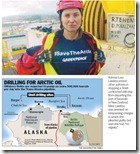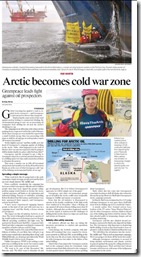Greenpeace leads fight against oil prospectors
Washington Times Daily 3 September 2012
 STOCKHOLM Global warming has ignited a rush to exploit Arctic resources — and Greenpeace is determined to thwart that stampede. Employing the same tactics it has used against nuclear testing or commercial whaling, the environmental group is now set on preventing oil companies from drilling for oil near the Arctic’s shrinking ice cap.
STOCKHOLM Global warming has ignited a rush to exploit Arctic resources — and Greenpeace is determined to thwart that stampede. Employing the same tactics it has used against nuclear testing or commercial whaling, the environmental group is now set on preventing oil companies from drilling for oil near the Arctic’s shrinking ice cap.
The campaign took off in May 2010, when oil was gushing from a ruptured well in the Gulf of Mexico. At the time, Greenpeace was startled by reports that a small Scottish energy firm was proceeding with plans to drill for oil and gas in iceberg-laden waters off western Greenland.
“It felt slightly surreal,” said Ben Ayliffe, now the head of Greenpeace’s campaign against oil drilling in the Arctic. “After what happened in the Gulf of Mexico, how can anyone respond to that by going to drill in similar depths in a place called Iceberg Alley?”

Greenpeace quickly arranged to get a ship to Greenland, where four activists attached themselves to a drilling rig for two days until a storm forced them to abandon the protest.
That stunt, a similar one in 2011 off Greenland and protests last month at an oil rig off northwestern Russia are at the core of what Greenpeace calls “one of the defining environmental battles of our age.”
Spreading a simple message
“Polar work feels like it’s going back to the early campaigns: simple message, people get it and the lines are very clearly drawn,” Mr. Ayliffe said.
From a publicity standpoint, the campaign has been successful: Greenpeace officials said 1.6 million people since June have signed the group’s online petition urging world leaders to declare the Arctic a global sanctuary, off limits to oil exploration and industrial fishing. Dozens of celebrities, including Robert Redford, Paul McCartney and Penelope Cruz have announced their support, said Greenpeace activist Sarah North.
“I have never experienced engaging famous people at this kind of rate and with such ease in a campaign issue,” said Ms. North, a 15-year veteran at Greenpeace.
The impact on the oil industry, however, is unclear. The Arctic is thought to hold up to a quarter of the world’s undiscovered oil and gas reserves. Despite difficult operating conditions and high costs, the payback for Royal Dutch Shell PLC, Gazprom OAO, Statoil and other companies searching for commercial quantities of hydrocarbons could be huge.
“It probably sounds a bit cynical. But if they invest billions of dollars, it’s not likely they will give it up just because somebody is attacking their oil rig,” said Mikhail Babenko, an oil and gas specialist at the World Wildlife Fund’s Global Arctic Program.
Unlike Greenpeace, WWF is not seeking a complete ban on drilling in the Arctic but wants to make sure the most vulnerable areas are protected.
“We want to be part of this discussion,” Mr. Babenko said. “We don’t want to stimulate oil and gas development. But if we follow [Greenpeace’s] approach, we will be simply out of the game.”
Greenpeace and other environmental groups say an oil spill in the Arctic could cause irreparable damage to wildlife and marine ecosystems.
Fears that the oil industry is ill-prepared to operate in the hostile conditions of the high north were reinforced in December when a floating oil rig capsized off eastern Russia, killing more than 50 workers. Although that accident happened outside the Arctic region, it underscored the challenges of drilling farther north, where ice ridges are yards deep and storms are frequent.
Industry cites safety concerns
Oil industry officials say they are taking the necessary precautions to conduct safe operations in the Arctic.
Cairn Energy, the Scottish company with platforms off Greenland that were targeted by Greenpeace protests in 2010 and 2011, is not drilling in the Arctic this year. By all accounts, that has nothing to do with Greenpeace but rather to the failure of the initial drilling.
Asked what, if any, impact the Greenpeace actions had on the company’s plans for Greenland, Cairn spokeswoman Linda Bain referred to the company’s second-quarter report, which does not say anything about Greenpeace.
Shell, which also has come into Greenpeace’s cross hairs for plans to drill off Alaska, also refused to discuss the group. However, Shell takes Greenpeace’s Arctic campaign seriously.
In March, Shell won an injunction by a U.S. judge ordering Greenpeace to stay more than a half-mile away from its drilling rigs in U.S. territorial waters.
A month earlier, New Zealand actress Lucy Lawless of the TV series “Xena: Warrior Princess” and six other Greenpeace activists climbed aboard one of the drilling rigs before it left for Alaska. They later pleaded guilty to trespassing charges and are awaiting sentencing.
Greenpeace activists also climbed aboard icebreakers contracted by Shell as the ships left the Baltic Sea. The Greenpeace ship Esperanza is shadowing Shell’s drilling vessels as they head north to bore exploratory wells in Alaska’s Chukchi and Beaufort seas.
“We will follow the oil industry into the Arctic,” Mr. Ayliffe said. “This is such an important campaign. We’re not going to let them off the hook that easily.”
Although Greenpeace sometimes is accused of being alarmist, environment and climate activists in general applaud the group for calling attention to global warming issues. Their activities don’t always resonate well, however, with some of the indigenous communities in the Arctic.
See more on the AUSXIP Lucy Lawless Save The Arctic Support Page for more news, photos, video and other multimedia
See more of Lucy's role as an Eco-Warrior and Greenpeace Ambassador